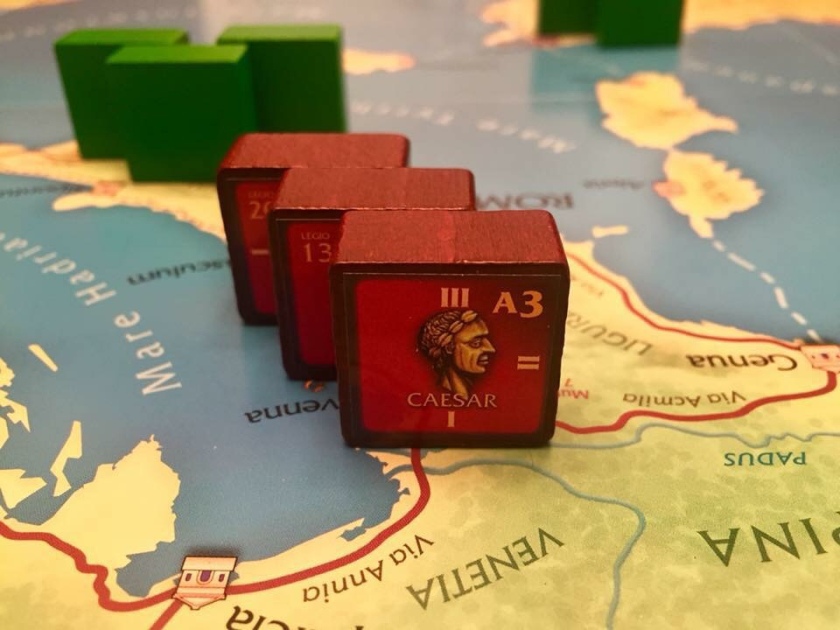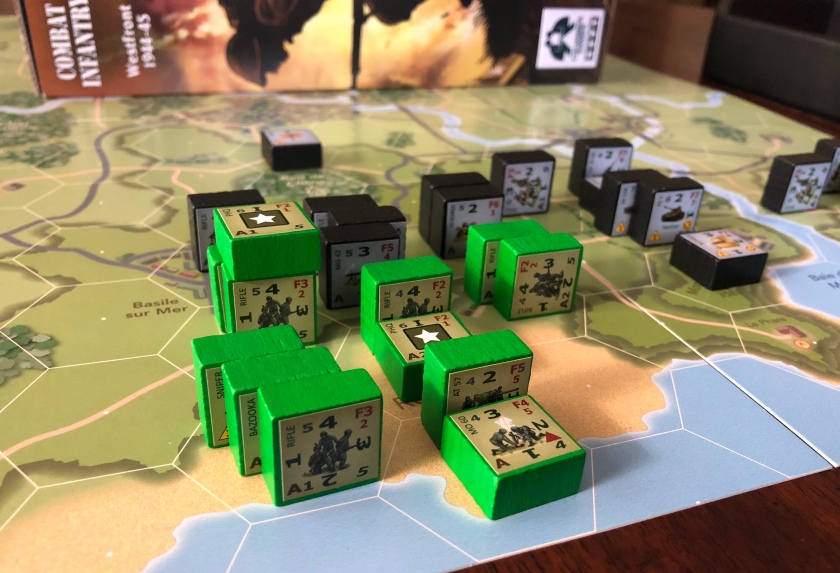Do you have a board game fan in your family? How about a history buff in your house? Maybe you know someone who loves to play traditional hex and counter war games? With the holidays fast approaching, and only a few shopping days left, have you thought about giving the gift of a block war game for Christmas?
For those not familiar with block games, veteran designer Steffan O’Sullivan (writing over 20 years ago) offered the following description:
“The wooden blocks are roughly 1″ by 1″ by 0.5″ -like half of a domino that can stand on end a little easier…Only one face has unit information on it. Normally, that side is kept towards the owner of the piece. This means that you can see all of your units, and what they are, and how strong they are, but you can only see the backs of your opponent’s pieces…”
“There are numbers around the edges of the side facing you. The number on top represents the current strength of the unit. As the unit takes a hit in combat, it is rotated to the next lower number, one step per hit until eliminated.”
In the past I have also written about the 3 things to look for in a good introductory block game. They are: low block count, ease of movement, and an appealing theme.
These three characteristics increase the accessibility of any block war game. They are also the reason why these games get the balance right between combat simulation and war game. The best block games, those that can appeal to both veteran gamers as well as players new to the hobby, are titles which accomplish this.
Based on this criteria, any one of the following titles make a great gift. Whether you are introducing war games to a history buff or historical block games to a war gamer, these epic conflicts fit the bill.

JULIUS CAESAR: Caesar, Pompey and the Roman Civil War 49-45BC. When Julius Caesar crossed the Rubicon in 49BC following his victory in the Gallic Wars, the act was treasonous and his intentions clear. Standing between Caesar and empire, however, was Pompey the Great. The Roman Civil War is brilliantly re-presented in Julius Caesar from Columbia Games.

Released back in 2010, the game is still considered by many to be Columbia’s best introductory block game.
Played on a 17″ x 33″ card stock board with 63 of Columbia’s big 24mm blocks, Caesar is a low complexity war game with a rules book coming in at a mere 8 pages long. This might be one of the best introductory block titles for experienced Eurogamers curious enough to venture into light war gaming.

NAPOLÉON: The Waterloo Campaign 1815 (4th Edition) has been a fan favorite of war gamers for over forty years. Much like Julius Caesar, unit movement in Napoléon is point to point on a large 22″ x 25″ mapboard. While this makes the game easier to play, it does nothing to reduce the strategic tension and tough decisions both players face.
Further, Napoléon utilizes a battle board in addition to the larger game board, providing players with both strategic level and tactical level decisions.

The game also features 58 of Columbia’s 24mm blocks, blue for the French, red for the Anglo-Dutch forces under Wellington, and black for Blücher’s Prussians. The art work, size of the blocks, and design of the map all combine for a game that is fun to play and a joy to see. In many ways this is an ideal game for the history buff looking for a good historical game to play.

COMBAT INFANTRY: WestFront 1944-45 is the newest of these three games, having just come out last year. It’s also the only one that is exclusively a tactical level war game.
As I noted previously in my review of the game:
“Combat Infantry includes units for one American and one German Infantry Battalion, as they were on the Western Front in 1944-45. As noted by Columbia, “This was considered the smallest force capable of attacking or defending major objectives.”
“Most blocks represent rifle squads of only 9-12 men, approximately 3 men per step. Machine guns, mortar teams, and other heavy weapons are teams of 2-3 men per step. Tanks & artillery are individual crews and vehicles. Compare this with games such as Bobby Lee or Napoléon where infantry blocks are at the brigade level, each step re–presenting approximately 3,000 men. Additionally, each hex in Combat Infantry depicts 100 meters.“

While Combat Infantry includes 132 blocks (66 U.S. and 66 German), the game still maintains a lower block count due to the nature of its six scenarios, which seldom utilize more than one Company per side.
Combat Infantry is a step up in complexity from both Julius Caesar and Napoléon, making it an excellent choice for the experienced war gamer possibly looking to try a block game for the first time.
From hex to hex movement, to line of sight restrictions, to more stringent stacking and hexside limitations, Combat Infantry definitely increases difficulty, but it does so without slowing down gameplay (as some squad level games tend to do).
So how about a block game for Christmas? Hopefully one of these three titles helps you to finish up your gift shopping this holiday season.
Photo credit: Brian Williams

